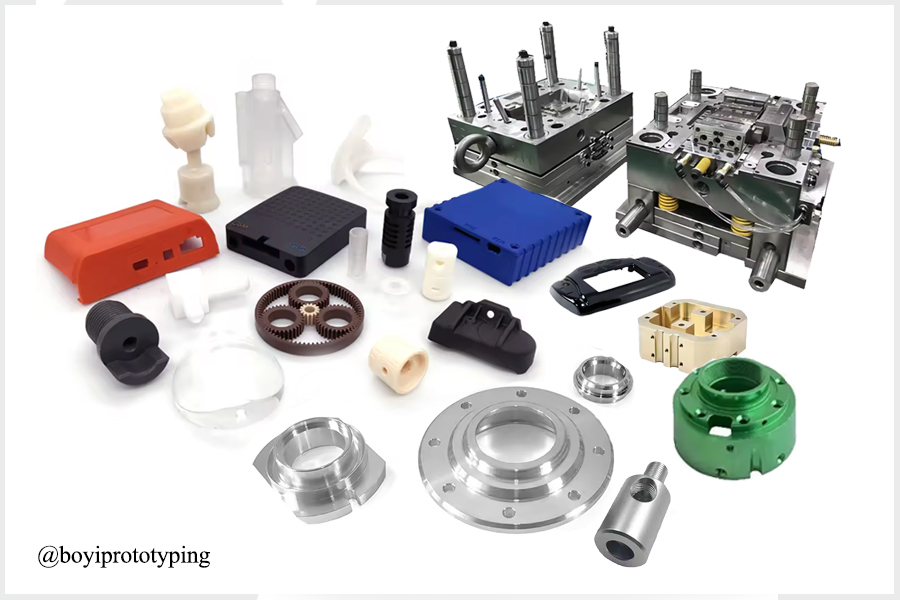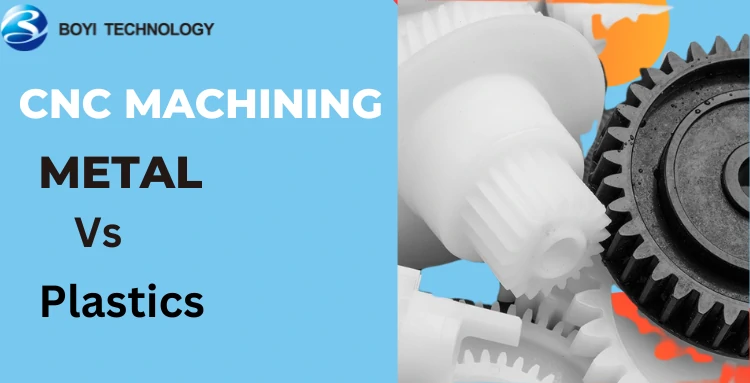CNC, or Computer Numerical Control, is a cornerstone technology in the modern manufacturing landscape. This advanced form of automated machining has revolutionized how we produce everything from simple tools to complex aerospace components. CNC machining stands out for its precision, efficiency, and ability to handle complex tasks that would be difficult or impossible with manual methods.
This article delves into the meaning of CNC, its operation, advantages, and disadvantages, and explores its history and future prospects.

What is CNC?
CNC, which stands for Computer Numerical Control, refers to the automated control of machining tools by means of a computer. These tools are often referred to as machining centers and are capable of producing plastic and metal parts with high precision. The process involves writing a computer program, typically in G-Code, an international standard language for CNC machines. This program contains parameters and instructions for the machine tool, such as material feed rates and the speed and positioning of tool components.
CNC Programming Language
Table 1: shows common programming languages for CNC machine tools
| Language | Overview | Functionality | Structure | Example |
|---|---|---|---|---|
| G-Code | The most widely used language for CNC programming. | Directs machine movements, controls spindle speeds, coolant flow, and tool changes. | Commands typically start with a letter followed by a numerical value. | G01 X1 Y1 F100 <br> M03 S1500 <br> (Moves to coordinates (X1, Y1) at a feed rate of 100 units/min, starts spindle at 1500 RPM.) |
| M-Code | Used alongside G-Code to control auxiliary machine functions. | Controls functions such as turning on/off coolant, starting/stopping the spindle, and changing tools. | Short commands that start with ‘M’ followed by numbers. | M06 T1 <br> M08 <br> (Changes to tool number 1, turns on coolant.) |
| APT (Automatically Programmed Tool) | An older high-level language for generating G-Code from 3D CAD models. | Specifies tool paths and operations in a more human-readable form. | Syntax closer to natural language. | PARTNO PART1 <br> CUTTER/0.5 <br> FROM/POINT1 <br> GOTO/POINT2 <br> (Defines a part, specifies cutter size, directs cutter from POINT1 to POINT2.) |
| STEP-NC | An emerging standard to replace G-Code with more detailed information. | Incorporates geometric and tolerance data for advanced manufacturing. | Compatible with STEP files. | Workplan 'Plan1' <br> setup 'Setup1' <br> machining_operation 'Operation1' <br> toolpath 'Path1' |
| Heidenhain Language | Used on Heidenhain controllers, known for its conversational style. | Simplifies programming with plain text prompts and instructions. | Consists of straightforward instructions. | L X+50 Y+50 FMAX <br> L Z-10 F300 <br> (Moves tool to coordinates (X+50, Y+50) at max feed rate, lowers tool to Z-10 at a feed rate of 300 units/min.) |
| Fanuc Macro B | An extension of G-Code for writing parametric programs. | Uses variables, conditional statements, and loops for complex operations. | Similar to traditional programming languages. | #100 = 10 <br> IF [#100 EQ 10] GOTO 20 <br> (Sets variable #100 to 10, checks if #100 equals 10 and jumps to line 20 if true.) |
Overview of CNC Machining
CNC machining is a versatile and precise manufacturing process that utilizes computer-controlled machinery to shape raw materials into finished parts. Unlike additive manufacturing methods such as 3D printing, which build up material layer by layer, CNC machining is a subtractive process where material is removed from a solid block to create the desired shape. This process has revolutionized the manufacturing industry by allowing for high precision, complex geometries, and efficient production.
History of CNC Machining
Before the advent of CNC machining, custom parts were produced manually by highly skilled machinists using tools like milling machines or lathes. Machinists would read blueprints and take precise measurements to guide their cutting operations. However, this manual process was time-consuming, labor-intensive, and limited in its ability to produce complex shapes and high tolerances.
The concept of CNC machining originated in the late 1940s and early 1950s. Initially developed by John T. Parsons in collaboration with MIT, the first CNC machines used punched tape as a data input method. This table summarizes the key milestones in the history of CNC machining, highlighting major developments and technological advancements over the decades.
| Year/Period | Development | Description |
|---|---|---|
| 1940s | Early Concepts | Initial ideas for numerical control (NC) emerged, driven by the need for greater accuracy in manufacturing. |
| 1949 | First NC Machine | John T. Parsons, along with Frank Stulen, developed the first numerical control machine, funded by the U.S. Air Force. |
| 1952 | MIT’s Contribution | MIT developed the first working CNC milling machine, utilizing punched tape to control machining operations. |
| 1960s | Commercialization | CNC technology began to be commercialized, with early adopters in the aerospace industry. |
| 1970s | Integration with CAD/CAM | Integration of Computer-Aided Design (CAD) and Computer-Aided Manufacturing (CAM) with CNC machines started, improving efficiency and precision. |
| 1980s | Microprocessor Advancement | The advent of microprocessors led to more sophisticated CNC controls and enhanced machine capabilities. |
| 1990s | PC-based Controls | Introduction of PC-based CNC controls made programming easier and more accessible, leading to wider adoption across industries. |
| 2000s | Multi-axis Machining | Development of multi-axis CNC machines (such as 5-axis machines) allowed for more complex and precise machining operations. |
| 2010s | Automation and Robotics | Increased integration of automation and robotics with CNC systems for enhanced productivity and reduced human intervention. |
| 2020s | AI and IoT Integration | Emerging trends include the integration of Artificial Intelligence (AI) and the Internet of Things (IoT) for smarter, more connected CNC operations. |
How CNC Works?
A CNC system consists of several key components, including the computer or controller, the machine tool (such as a lathe or milling machine), and the software used for programming.
- CAD Design and Programming: The CNC process begins with engineers creating a detailed computer-aided design (CAD) drawing of the part to be manufactured. This CAD drawing serves as the blueprint for the final product, specifying its dimensions, features, and tolerances.Next, the CAD drawing is converted into a set of instructions called G-code. G-code is a standardized language that communicates the precise movements and operations that the CNC machine will perform to create the part.
- Loading and Testing the Program: Once the G-code program is generated, it is loaded into the machine control unit (MCU) of the CNC machine. The CNC machine operator then conducts a test run of the program, without the raw material in place, to ensure that the machine performs as expected. During this test run, the operator verifies the accuracy of the tool paths, positioning, and cutting speeds.
- Execution on CNC Machine: The CNC machine executes the CAM instructions, using motors and drives to move the tool and workpiece with high precision to create the desired part.
CNC machining offers higher precision, complexity, and flexibility compared to manual machining. It allows for contour machining, enabling the production of complex shapes and 3D designs. However, CNC machines require significant investment and skilled operators to program and maintain.
Types of CNC Machines
Different types of CNC machines are tailored for specific tasks, each offering unique capabilities to suit various applications
- CNC Milling Machines: These machines use rotating cutting tools to remove material from a workpiece, creating intricate shapes and surfaces.
- CNC Lathes: In these machines, the workpiece rotates while a stationary cutting tool shapes it, ideal for producing cylindrical parts.
- CNC Routers: These are used for cutting and shaping materials like wood, plastic, and composites, commonly used in woodworking and signage industries.
- CNC Plasma Cutters: These machines use a high-velocity jet of ionized gas (plasma) to cut through electrically conductive materials, such as steel and aluminum.
Applications of CNC Machining
CNC machining is used across various industries for producing a wide range of components and products, including:
- Aerospace: Engine components, aircraft structures
- Automotive: Engine parts, transmission components
- Medical: Surgical instruments, implants
- Electronics: Circuit boards, casings
- Machinery: Nut and bolt
Advantages and Limitations of CNC
| Advantages | Limitations |
|---|---|
| High Accuracy and Precision | Initial Investment and Maintenance Costs |
| Increased Efficiency and Productivity | Skilled Labor Requirement |
| Complexity and Versatility | Complex Programming |
| Reduced Waste and Material Usage | Machine Downtime and Breakdowns |
| Consistency and Reproducibility | Limited Flexibility for Small Batch Sizes |
| Enhanced Safety | Complexity in Handling Certain Materials |
| Automation of Manufacturing Processes | / |
| Faster Turnaround Times | / |
| Cost Savings through Reduced Material Wastage | / |
| Ability to Produce Complex Geometries | / |
| Versatility in Working with Various Materials | / |
| Customization and Adaptability | / |
| Improved Quality Control | / |
| Long-term Cost Savings | / |
| Reduced Risk of Errors and Variability | / |
Importance of CNC technology
CNC (Computer Numerical Control) technology is crucial in modern manufacturing, offering unparalleled precision, efficiency, and flexibility. It enables the production of complex and highly accurate parts essential for industries such as aerospace, automotive, and medical devices. CNC machines operate continuously with minimal human intervention, significantly increasing productivity and reducing errors. Their ability to be quickly reprogrammed for different tasks allows manufacturers to respond swiftly to changing demands, making production processes more adaptable and cost-effective. Furthermore, CNC technology improves safety by minimizing manual intervention and reducing the risk of accidents. As advancements like AI and IoT integration continue, CNC’s role in enhancing manufacturing capabilities and driving innovation will only grow, cementing its importance in the industry.
Future of CNC Machining
The future of CNC machining is promising, with continuous advancements in technology. Integrating artificial intelligence (AI) and the Internet of Things (IoT) can further enhance automation, predictive maintenance, and real-time monitoring. Emerging trends such as additive manufacturing (3D printing) are complementing traditional CNC processes, expanding the possibilities in manufacturing. These advancements will likely lead to increased efficiency, reduced costs, and broader applications of CNC technology in various industries.
Conclusion
CNC machining has transformed the manufacturing landscape by offering unparalleled precision, efficiency, and versatility. As technology continues to advance, CNC machining will remain a cornerstone of modern manufacturing, enabling the production of increasingly complex and innovative products.
Use the CNC machining services provided by BOYI to help your project achieve success. Contact us now to get a free quote.

Let’s Start A New Project Today
Our engineers will contact you within 2 hours.
FAQ
CNC machining differs from traditional machining in that it uses computer programs to control the movement and operation of machine tools. This allows for greater precision, consistency, and efficiency, as well as the ability to produce complex and intricate parts that would be difficult or impossible with manual machining.
Industries that benefit the most from CNC machining include automotive, aerospace, medical, electronics, and consumer goods. These industries rely on CNC technology for producing high-precision and high-quality parts and components.
Catalog: CNC Machining Guide

This article was written by engineers from the BOYI team. Fuquan Chen is a professional engineer and technical expert with 20 years of experience in rapid prototyping, mold manufacturing, and plastic injection molding.




